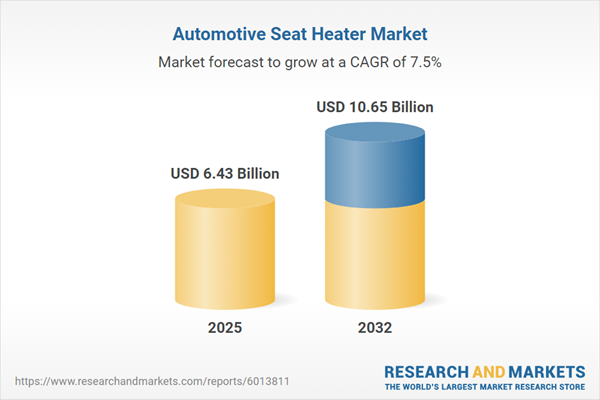Speak directly to the analyst to clarify any post sales queries you may have.
The automotive seat heater market is entering a critical phase defined by rising consumer comfort standards, regulatory momentum, and technological progress. Senior stakeholders face growing pressure to steer investments strategically as the sector evolves across supply chains, product innovation, and compliance objectives.
Market Snapshot: Automotive Seat Heater Market Performance
The global automotive seat heater market achieved a valuation of USD 5.98 billion in 2024, and is projected to expand to USD 6.43 billion by 2025, accompanied by a Compound Annual Growth Rate (CAGR) of 7.47%. Long-term projections estimate the market reaching USD 10.65 billion by 2032, guided by robust demand for customizable cabin environments, efficiency-enhancing solutions, and sophisticated thermal technologies. Product development is fueled by sensor integration, advanced materials, and deeper collaboration among leading industry firms, supporting sustainable and scalable seating solutions for evolving requirements worldwide.
Scope & Segmentation in the Automotive Seat Heater Market
This report provides granular segmentation and analysis to direct informed investment and operational strategies in the automotive seat heater market:
- Channel: Evaluates both OEM and aftermarket supply channels, guiding organizations to spot factory integration potential and post-sale retrofit opportunities in diverse automotive value chains.
- Technology: Examines the adoption of carbon fiber heaters, Positive Temperature Coefficient (PTC) elements, and conventional resistive systems, informing decisions on differentiation, compatibility, and cost reduction; emerging sensor technologies contribute to user-focused comfort.
- Fuel Type: Considers market penetration across electric, hybrid, and internal combustion vehicles, aligning strategies with electrification trends, decarbonization initiatives, and future mobility concepts.
- Seat Position: Assesses the allocation and customization of seat heater systems for front and rear seat applications, serving specific needs across sedans, SUVs, and multifunctional vehicle platforms.
- Heating Zone: Appraises solutions from single-zone to multi-zone controls, supporting manufacturers as they design customizable and climate-adaptable heating offerings for global and local passenger needs.
- Regions: Delivers dedicated analysis of the Americas, Europe, Asia-Pacific, Middle East, and Africa, contextualizing regional conditions such as consumer demand, regulatory influences, and climate-based adoption patterns.
- Leading Companies: Highlights contributions from prominent organizations including Lear Corporation, Adient plc, Faurecia SE, Magna International Inc., Toyota Boshoku Corporation, Grupo Antolin-Ingeniería, Dräxlmaier Group, Brose Fahrzeugteile GmbH & Co. KG, DENSO Corporation, and Motherson Sumi Systems Limited while mapping collaborative technology strategies shaping the market’s direction.
Key Takeaways for Senior Decision-Makers
- Adoption of next-generation seat heater technologies positions organizations to meet shifting expectations for cabin comfort while strengthening their supplier relationships in changing automotive markets.
- Integrating wireless controls and ultra-thin heating modules enables manufacturers to differentiate user experiences and respond quickly to competitive demands in vehicle design.
- Pursuit of lightweight and efficient seat heating solutions underpins sustainability goals and helps automotive players comply with varied energy performance requirements.
- Agile supply chain management, including the expansion of local and regional supplier networks, enhances responsiveness to market developments and mitigates regulatory or logistical disruptions.
- Collaboration between OEMs and technology providers has become central to accelerating the deployment of advanced heating system interfaces, elevating both performance and adaptability of automotive seating systems.
- Ongoing monitoring of international trade trends and adapting sourcing models ensure continued business continuity amidst evolving policy and market challenges.
Tariff Impact: Navigating U.S. Import Developments
Shifting U.S. tariff frameworks have raised import costs for seat heater components, prompting a strategic reassessment of procurement and supply choices. Manufacturers are responding by evaluating domestic production options and forming new regional partnerships, reinforcing the imperative of resilient and flexible supply chains in a rapidly changing regulatory environment.
Methodology & Data Sources
This report synthesizes comprehensive market research, regulatory analysis, and qualitative input from industry executives and key stakeholders. Quantitative findings draw on global trade and financial data, augmented by scenario modeling to assess the effects of regulatory and technological shifts on future market growth and structure.
Why This Automotive Seat Heater Market Report Matters
- Equips executive leadership with concrete direction for investment in innovative comfort solutions and operational optimization, supporting business alignment with the latest automotive seat heater market trends.
- Delivers continuous updates on regulatory changes, supply chain strategies, and technology transitions, empowering decision-makers to mitigate risks and seize emerging opportunities.
- Supports the creation of precise segmentation and product launch plans, improving go-to-market effectiveness across regions, vehicle platforms, and end-user preferences.
Conclusion
Senior decision-makers leveraging this analysis gain a foundation to accelerate innovation, streamline supply operations, and pursue regionally targeted initiatives for ongoing differentiation and market strength.
Additional Product Information:
- Purchase of this report includes 1 year online access with quarterly updates.
- This report can be updated on request. Please contact our Customer Experience team using the Ask a Question widget on our website.
Table of Contents
3. Executive Summary
4. Market Overview
7. Cumulative Impact of Artificial Intelligence 2025
Companies Mentioned
The companies profiled in this Automotive Seat Heater market report include:- Lear Corporation
- Adient plc
- Faurecia SE
- Magna International Inc.
- Toyota Boshoku Corporation
- Grupo Antolin-Ingeniería, S.A.
- Dräxlmaier Group
- Brose Fahrzeugteile GmbH & Co. KG
- DENSO Corporation
- Motherson Sumi Systems Limited
Table Information
| Report Attribute | Details |
|---|---|
| No. of Pages | 198 |
| Published | October 2025 |
| Forecast Period | 2025 - 2032 |
| Estimated Market Value ( USD | $ 6.43 Billion |
| Forecasted Market Value ( USD | $ 10.65 Billion |
| Compound Annual Growth Rate | 7.4% |
| Regions Covered | Global |
| No. of Companies Mentioned | 11 |









